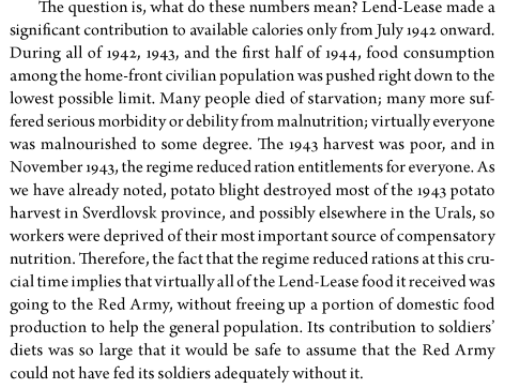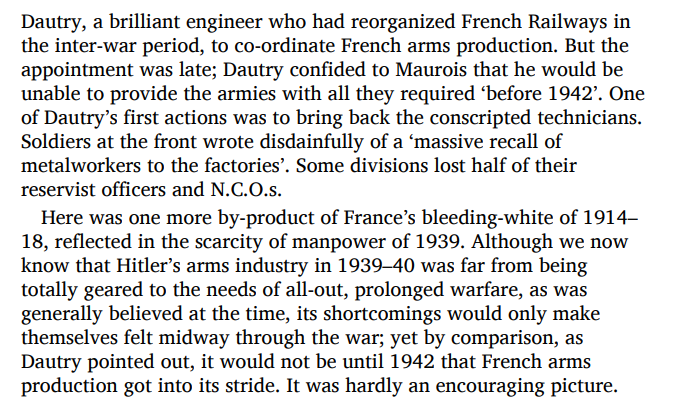For my own take, with regards to the UK, I cite from Denis Havlat (2017)
Western Aid for the Soviet Union During World War II: Part I,
The Journal of Slavic Military Studies:
Between January 1939 and June 1940, the combined French and British orders of military planes had amounted to 10,800 machines; yet from January to May 1940 Britain had received only 104 and France 557 aircraft.19 While these deliveries were certainly helpful for the Allies, they were not enough to stem the advance of the Germans into Western Europe. In fact, after the disaster at Dunkirk, where the British Expeditionary Force (BEF) narrowly escaped capture by the German army, the demand for American deliveries increased significantly. The soldiers evacuated from the beaches of Dunkirk had left behind vast amounts of materiel and equipment, which was impossible to quickly replace. BEF equipment abandoned in France included 120,000 vehicles, 600 tanks, 1,000 field guns, 500 anti-aircraft guns, 850 antitank guns, 8,000 Bren machine guns, 90,000 rifles, and half a million tons of stores and ammunition.20 British Prime Minister Winston Churchill sent a desperate message to Roosevelt asking for more deliveries, a request Roosevelt made possible by exporting ‘outdated’ weapons from US Army stocks.21
A dozen ships fully loaded with weapons and supplies sailed for Britain in June and a further 15 from July to early August.22 In total, Britain received 500,000 rifles, 85,000 machine guns, nine hundred 75 mm field guns, 25,000 automatic rifles, and 21,000 revolvers, including substantial amounts of ammunition.23 In order to comprehend the value of these deliveries, one has to compare them to British production of these items, which amounted to 193,712 rifles and 85,924 machine guns in the years 1939–1941.24 Within eight weeks, the United States had delivered two and a half times as many rifles and the same amount of machine guns as British industry had managed to produce in three years.
But infantry weapons and guns were not the only items that Britain needed in order to survive. The nation needed aircraft to defend itself from the bombing raids conducted by the Luftwaffe and warships for the escort of merchant vessel convoys. Both of these items were readily supplied by the Americans. Through the so-called Destroyers for Bases agreement, Britain received 50 renewed World War I destroyers from American stocks. Of these, nine were in service by the end of 1940 and a further 20 by May 1941.25 These ships were of immense value, in view of the fact that by the end of 1940 fully 70 percent of the British destroyer fleet was laid up for repairs and that domestic production had turned out just 88 of these vessels from 1939 to 1941.26 By the summer of 1943, only five of these destroyers had been sunk, while the other 45 were still providing escort duty.27
With the Battle of Britain raging in the summer and autumn of 1940, British demand for aircraft reached new heights as well. By 1 December 1940, Britain had ordered a staggering 23,000 aircraft from the American industry, of which only 2,100 had been delivered to the beleaguered island.28 Domestic production of aircraft for that year had been 15,049 aircraft.29 While these shipments were invaluable for Britain’s survival, they came at great financial cost. In order to purchase the 50 destroyers offered by the United States, the British had to sell their possessions in the West Indies and Newfoundland, leasing them to the Americans for 99 years.30 Even then, the strains of war were too great a burden for the British economy:
British industry was incapable of producing the range and quantity of armaments required to win the war. Even those items that could be manufactured domestically were heavily dependent on imports of raw materials and products such as steel. Most of these imports came from the United States and had to be paid for either in gold or dollars… . The day of reckoning was rapidly approaching. From a total of £775 million at the beginning of 1940, Britain’s gold and dollar reserves … had fallen [by August 1940] by over a third to £490 million… . They would last another three to four months at most. By the end of 1940, therefore, Britain would be unable to carry on the war by its own efforts.31
By September 1940, British orders in the United States amounted to 10 billion dollars, of which only a fraction could be paid for.32 The country was nearing financial collapse: ‘ … by the beginning of 1941 it had less than £3 million left in its gold and dollar reserves. This was as near to bankruptcy as it was possible to go without actual default’. 33 Realizing that without American aid Britain would have to surrender or negotiate with Germany, Roosevelt devised the so-called Lend-Lease law, which took effect on 11 March 1941. This law gave the President the authority to supply any country that was considered vital for the defense of the United States.34 For the duration of the war, Britain would receive supplies free of charge, which would be handed back or repaid once the war had ended.
Further on:
Even with the deliveries received from the United States, Britain’s military position in 1941 was close to hopeless. During the first half of this year the Luftwaffe continued its bombing raids against the island, Rommel’s forces were steadily advancing in North Africa, British forces sustained yet again humiliating defeats in Greece and Crete, and the German U-boats were sinking ever more British ships. Luckily, the Americans were now supplying Britain for free. In 1941 the United States delivered 4,473 aircraft either directly to Britain, to British overseas commands, or to British colonies and dominions.35 British production of aircraft in 1941 had been 20,094 units; whereas the colonies and dominions produced around 15 percent of this number.36 Other substantial military deliveries were tanks and trucks. Around 13,000 trucks and 1,390 tanks were shipped to Britain and its overseas forces before the end of 1941.37 Domestic production in 1941 had manufactured 4,841 tanks and 88,161 military trucks.38 Food represented the most crucial non-military supply. Before the war Britain had to import twice as many tons of food from overseas sources as raised on her own land.39 However, by the summer of 1940 Britain could no longer import food from continental Europe and had to cut down its food imports from other parts of the world in order to free shipping capacity for military supplies and resources. In combination with the many shiploads of food lost to the German U-boats, this created a situation where the British nation was close to starvation. Between the fall of France and the passing of the Lend-Lease act, the average British adult lost around 4.5 kilogram of weight due to the rapidly shrinking diet.40 Between 16 April and 25 December 1941, the Americans supplied Britain with over one million tons of food, including millions of concentrated vitamin tablets to counter a vitamin shortage caused by strict rationing.41 Shipments continued to increase, delivering 1.427 million tons in 1942, 1.705 million tons in 1943, 1.28 million in 1944, and 709,000 tons in 1945.42 On average, this amount of food was sufficient to feed over 4 million people during the years 1941–1945, around 10 percent of the British population.43
Besides the deliveries sustaining the British population and industry, American aid contributed decisively in stopping Rommel’s advance in North Africa. By 24 October 1942, American deliveries to North Africa and the Middle East amounted to 900 medium tanks, including 300 Sherman tanks that were of better quality than anything the British had before, as well as ninety 105 mm self-propelled anti-tank guns, 800 light tanks, 25,000 trucks and jeeps, over 700 twin-engine medium bombers, and nearly 1,100 fighters.44 The percentage of military equipment supplied to the British armed forces from American sources was 11.5 percent in 1941, 16.9 percent in 1942, 26.9 percent in 1943, and 28.7 percent in 1944.45 Even these figures understate the full magnitude of American aid to the British Empire. In 1942 the United States supplied 9,253 tanks and 5,898 aircraft, while British industry had turned out just 8,611 tanks and 23,672 aircraft.46 In 1943 American supplies had increased to 15,933 tanks and 6,710 aircraft, while British manufacture of tanks had decreased to 7,476 and aircraft production increased only modestly to 26,263 machines.47 In 1944, at the height of these deliveries, the United States supplied the British Empire with a staggering 11,414 aircraft, while the British produced 26,461 during that year.48 Total US deliveries of aircraft to the British Commonwealth amounted to nearly 34,000 units.49 Throughout the years 1941–1944 the United States delivered between one-fifth and one-third of total British Empire aircraft production. The share of American tanks was even greater; it increased from approximately 20 percent in 1941, to 100 percent in 1942, and to 200 percent of the total British Empire production in 1943. During the last two years of the war, Britain alone received, among other things, 76,737 Jeeps, 98,207 trucks, 12,431 tanks, and 6,715 000 tons of steel and iron.50 By 1944 around two-thirds of the tanks and trucks in the British army came from the United States.51 The total value of the aid delivered to the British Empire amounted to slightly more than 30 billion dollars.52
By the summer of 1941, the island nation was fully dependent on American deliveries, having been transformed into a giant unsinkable aircraft carrier similar to the ‘Airstrip One’ described in George Orwell’s novel 1984. Without American deliveries, Britain would either have been starved into submission or collapsed financially. Even if these two scenarios could somehow have been avoided, British industry would have produced fewer weapons than historically, since it was dependent on overseas deliveries of resources from the United States. The absence of these resources, combined with the lack of Lend-Lease tanks, aircraft, motor vehicles, small arms, and artillery, would have meant a far weaker and far worse-equipped British army, navy, and air force. British victory in North Africa would have thus become unlikely, a successful Bomber Offensive improbable, and an invasion of continental Europe impossible.
Without American aid, the UK would've thus been compelled to seek a peace deal with the Germans no later than early 1941 IMHO.


